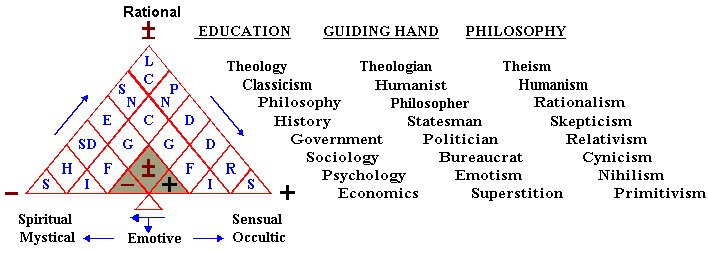
Truth is relative to viewpoint, perception, and perspective. This may be explained, illustrated, related, developed, and unified on one of the eight Trinitarian structures, the Perspective Structure, as shown below, with examples of relative values and ideas:

The Perspective Structure looks like a railroad track that disappears into the horizon. It is analogous to a person standing in the middle of the track as he looks down at his feet. There he sees only gravel. As he looks to his right, he sees the right track, but loses sight of the left track and the gravel in the middle. He cannot see the three sides at the same time. To see one side, in balancing change, he loses sight of the other two sides. His viewpoint changes. He has the narrow-range perspective of a factual scientist, who sees only the detailed diversity without unity.
As the person looks half-way down the tracks, toward the horizon, he sees that the left-middle-right views of the tracks merge. He sees all three sides at the same time. He sees a unified, systemized trinity of view, but no details. He can reason, imagine, and speculate to envision details in his perspective perception. In balancing change, he cannot see the detailed gravel or tracks at his feet, To see this broader range of perspective, in balancing change, he losses sight of the narrower range. He has the medium-range perspective of the abstract, conceptual philosopher who sees unity with diversity.
As the person looks at the horizon, the tracks merge to be just a dot, a unity. He sees that his previous knowledge of a diversity without unity, has merged into a unity without diversity. But in seeing the whole, in balance, he loses sight of the parts. He loses sight of concrete facts and abstract concepts relative to the tracks. He has the broad-range perspective of the metaphysical system-philosopher who seeks for abstruse ultimate truth in the ultimate unity of ultimate principles that encompass all that led to it.
The person now peers beyond the horizon, into the sky. This is where the theologian peers into the unknown; to view images that are based on faith, that have no concrete data. In so doing he loses sight of what the metaphysician, the philosopher, and the scientist could see and know. He has the broadest of all perspectives, but one that is not verifiable by observable fact or systematic reason.
On the same principle, truth is relative to the Progressive Ranges of Society and Values. Truth is relative to one's perspective as an individual, family, group, city, nation, civilization, and humanity. The principles of perspective are the same on all of these social ranges, but their relative facts differ because of their relative viewpoint, perception, and perspective. Truth is most relative to being changed on the narrow individual-range of concrete facts, less on the medium city-range of concepts, and least on the broad range of humanity with its universal abstruse principles. Facts for diversity, concepts for harmony, principles for unity. Only one of these may be perceived at a time, relative to perspective. .
Three men looked out of prison bars: one saw mud; one saw trees; and one saw stars. Which saw the true reality? One of these looked at stars to hide his cares, but when he looked back, his cares were still there. Another one looked at stars, but fell in mud. So he then looked at mud, but saw no stars. Which was the true and best reality? On a trinity of broad-medium-narrow ranges of perspective all viewpoints perceptions, and perspective are true, but relative to balancing changes in observation.
There is a balancing change between the values of a trinity of truth. This includes the trinity of perspectives, that changes between broad-medium-narrow ranges of truth. As one range of perspective is focused on, in balance, the other perspectives are submerged; and with them, their truths are submerged. That is why three persons may view the same railroad tracks differently. Each may speak a different truth, yet each will deny the truth that is claimed by the others. Only a flexible perspective, between broad-medium-narrow ranges enables a view of the whole trinity of truth.
To perceive the whole truth, one's flexible perspective must change to see the whole as a unity of diversity. The major part is a unity relative to the minor, detailed parts of a diversity. Partial relative truths change; while the whole absolute truth remains unchanged. To see the whole perspective of truth is to be a Renaissance man, one who can make balancing changes in his broad-medium-narrow ranges of perspective. This makes the Renaissance Man to be adept in theology-philosophy-science, or in spiritual-rational-sensual truths, that are intuitive-logical-empirical.
An example of the use of perspective, by means of the Perspective Structure is shown below in terms of educational values, The "Guiding hands", and the kinds of philosophy. Parallel the Progressive Ranges of Society (I, F, G, C, N, C), and the Calendar of Human Change (S, H, SD, E, S, L, P, Di, De, R, S):
